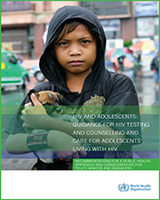Overview
Adolescents (10–19 years) and young people (20–24 years) continue to be vulnerable, both socially and economically, to HIV infection despite efforts to date. This is particularly true for adolescents — especially girls — who live in settings with a generalized HIV epidemic or who are members of key populations at higher risk for HIV acquisition or transmission through sexual transmission and injecting drug use. In 2012, there were approximately 2.1 million adolescents living with HIV. About one-seventh of all new HIV infections occur during adolescence.
These guidelines provide specific recommendations and expert suggestions — for national policy-makers and programme managers and their partners and stakeholders— on prioritizing, planning and providing HIV testing, counselling, treatment and care services for adolescents.
The designations employed and the presentation of the material in this publication do not imply the expression of any opinion whatsoever on the part of the World Health Organization concerning the legal status of any country, territory, city or area or of its authorities, or concerning the delimitation of its frontiers or boundaries. Dotted lines on maps represent approximate border lines for which there may not yet be full agreement.
The mention of specific companies or of certain manufacturers' products does not imply that they are endorsed or recommended by the World Health Organization in preference to others of a similar nature that are not mentioned. Errors and omissions excepted, the names of proprietary products are distinguished by initial capital letters.
All reasonable precautions have been taken by the World Health Organization to verify the information contained in this publication. However, the published material is being distributed without warranty of any kind, either expressed or implied. The responsibility for the interpretation and use of the material lies with the reader. In no event shall the World Health Organization be liable for damages arising from its use.

